Traditional Chinese Medicine: A Comprehensive guide on 12 Meridian Channels 1
Just as western medicine studies and treats the physical body, eastern medicine studies and treats the energy body. Medicine Chinese, also known as Traditional Chinese Medicine recognizes fourteen meridian channels as the vital conduits of our energy flow. Two of these channels ride through our spinal fluid, the other twelve (also called limb meridians) ride through our fascial system which lies between our skin layers and our muscles.
These channels are marked by points that left stagnant tend to capture energy, thus creating blockages that interrupt the flow. To the degree that these points lie close to our skin, they may be treated by acupuncture as also by acupressure to release the blockage and free up the flow. For the points that lie deeper, one may practice Qi Gong, Tai Chi, or internal Martial Arts to disrupt and release such blockages.
I studied these meridians from a bird’s eye view to see how they interconnect and what that says about our energy being. My intent was to rise at a level of overview from where I could commit the system to memory, thus call it down quickly as I worked the practice of acupressure.
The twelve limb meridians
The twelve limb meridians are:
- LU Lung
- LI Long Intestine
- ST Stomach
- SP Spleen
- HT Heart
- SI Short Intestine
- UB Urinary Bladder
- KD Kidney
- PC Pericardium
- TW Triple Warmer
- GB Gall Bladder
- LV Liver
Traditional Chinese Medicine recognizes the above to be the order to meridian flow. Please recognize the meridian names as short labels. Given how everything is interconnected, the label does not indicate the specific organ to be the only part of us energized by the meridian.
The twelve are referred to as limb meridians because they either start or end in our limbs.
- There are six yang meridians that descend and ride on the exposed or outer parts of the limbs. These are shown in red below.
- There are six yin meridians that ascend and ride on the covered or inner parts of the limbs. These are shown in green below.
In picturing the flow, please imagine our arms raised.
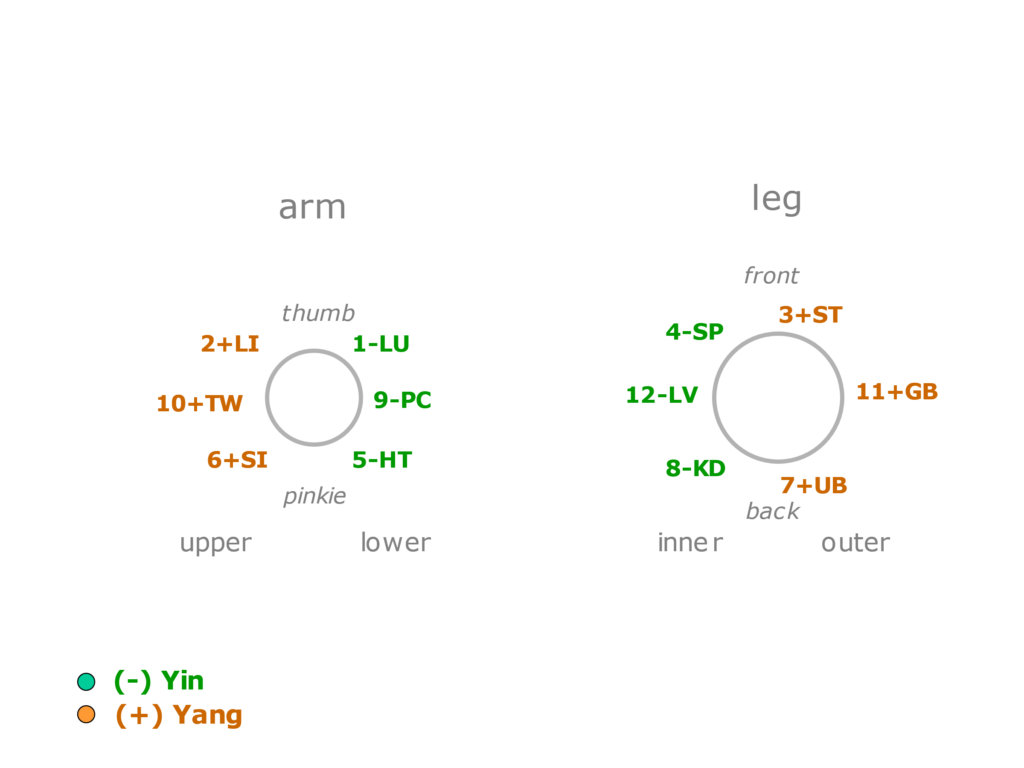
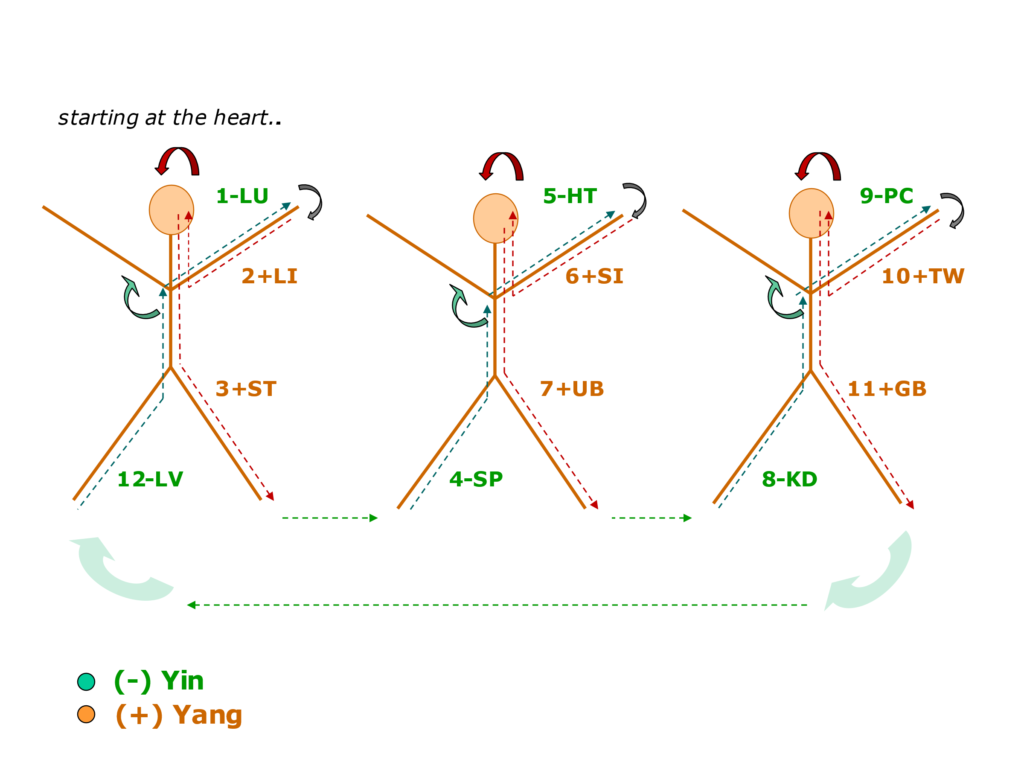
Meridian Transitions
Meridian transitions occur as energy reaches the end of one meridian and from there leaps to the beginning of the next. I mark them here with the traditional acupuncture points.
The yang meridians occur in pairs. The first draws the energy of the sun/spirit through the fingers, down the arm then up the neck to the head. The second leaves the head and descends through the torso and the leg to exit through the toes.
Yang to yang transitions occur between:
- meridians 2-LI and 3-ST (the link occurs between LI-20 and ST-1)
- meridians 6 SI and 7 UB (the link occurs between SI-18 and UB-1)
- meridians 10 TW and 11 GB (the link occurs between TW-23 and GB-1)
The yin meridians also occur in pairs. The first draws the energy of the earth through the foot/toes, up the leg through the torso to the heart. The second leaves the heart, rides up the chest through the arm to exit at the fingertips.
Yin to yin transitions occur between:
- meridians 12 LV and 1 LU (the link occurs between LV-14 and LU-1)
- meridians 4 SP and 5 HT (the link occurs between SP outer and HT inner)
- meridians 8 KD and 9 PC (the link occurs between KD-27 and PC-1)
Notice how the head region is the transition from one yang meridian to the next, while the heart region is the transition from one yin meridian to the next. That speaks volumes about the difference we observe between our masculine, or head and feminine or heart influence.
Transitions at our fingertips move from yin to yang as follows:
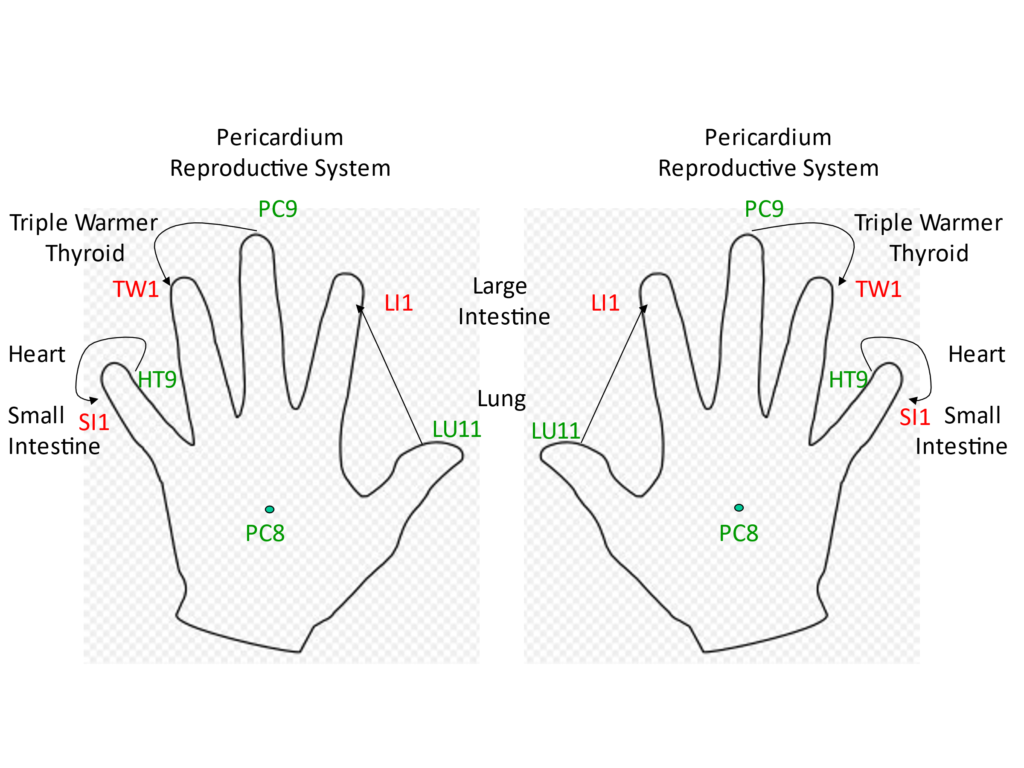
Transitions at our toes move from yang to yin as follows:
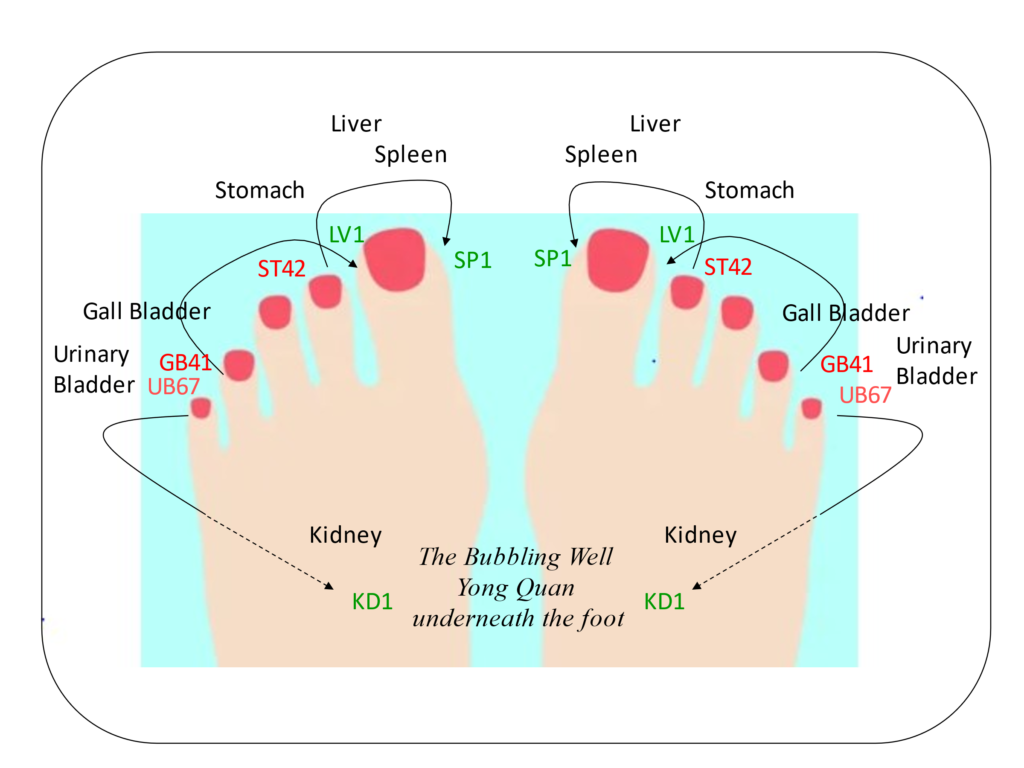
The 24-hour clock
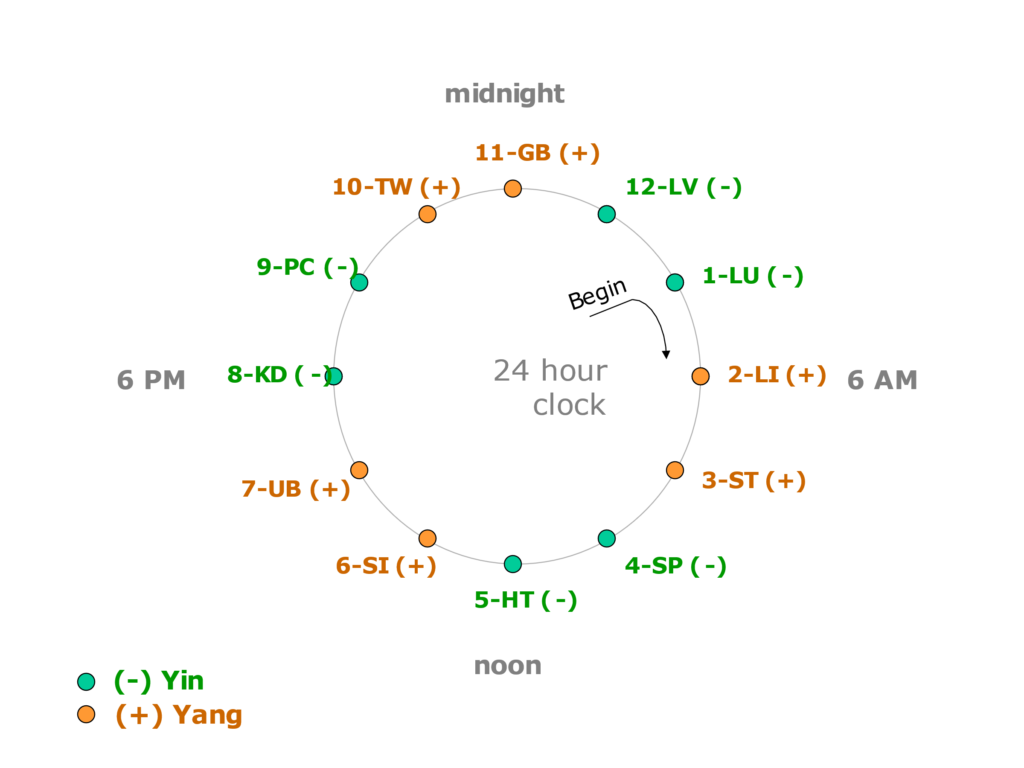
Each meridian is considered to operate at peak during 2 hours in a 24-hour period. This means that between1 and 3 am we may notice a heavy liver, between 3 and 5 am the need to rid our head of accumulated sinus, between 5 and 7 am we experience the urge for a bowel movement, between 7 and 9 am we savor some breakfast and so on.
The Microcosmic Orbit
In addition to the twelve limb meridians, Chinese Medicine recognizes two more major meridians running up and down our spine. The two spine meridians are:
- DU Du Mai or Governing Vessel
This rides up the back of the spine - RN Ren Mai or Conceptual Vessel
This rides down the front of the spine.
Learning to flow these meridians as a wheel coming down the front and riding up the back is essential to energy healing and is taught in each of the modalities. This is referred to as the enabling of the microcosmic orbit which is like moving from AC to DC in electricity. Energy will now flow through the healing hands, especially Pericardium 8 in the center of the palm.
The Microcosmic Orbit must be set to motion consciously as the two channels that make it up are separated in our mouth and in our saddle point.
- The DU Mai or Governing Channel starts in the back of our saddle point, rides up the spine to the Bai Hui or crown of the head and then down the face to the top of the mouth, right behind the teeth.
- The Ren Mai or Conceptual Vessel starts in the front of our saddle point and rides up the front of the spine, through our chin to the tip of our tongue.
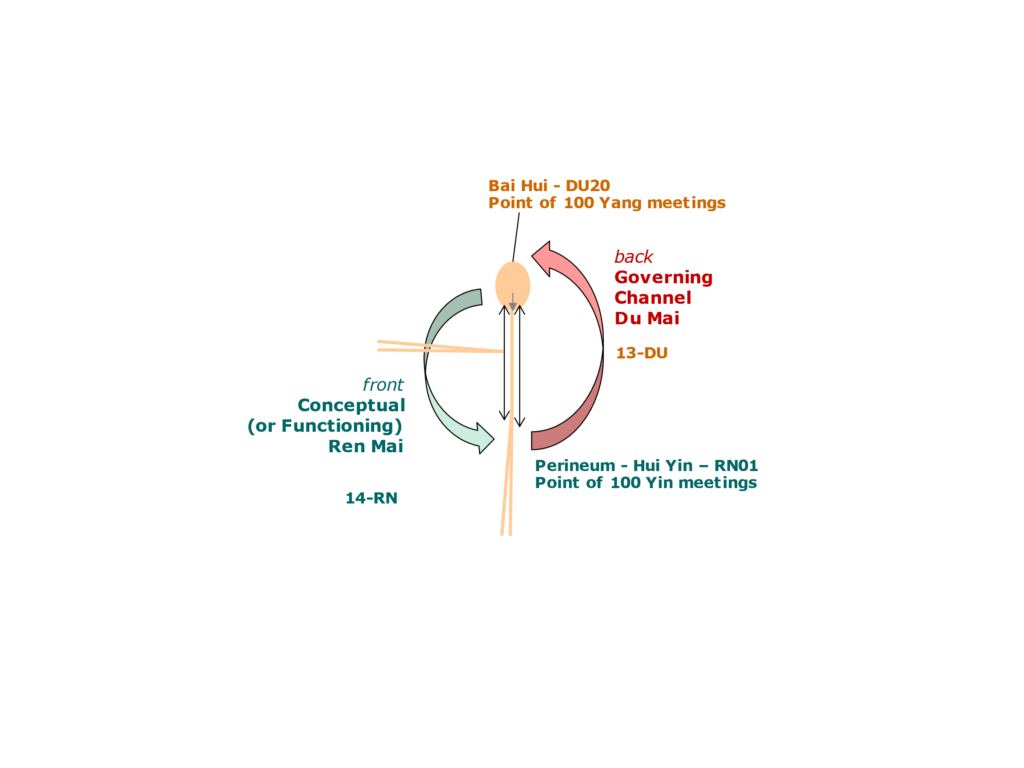
A healing master practices with the Hui Yin (perineum or saddle point) closed at the root center (RN-1 must link to DU-1) and the tongue reaching the roof of the palate (DU-28 must link to RN-24). This changes the master’s dual (up and down) channel flow to the single channel of the Hara line.
While in dual channel mode we seek out sex (upper and lower) as a way to activate this orbit, all be it momentarily, while the two bodies remain in contact. Risen masters often feel a wave of energy similar to that attained through orgasm while they practice the microcosmic orbit.
Qi Gong, or the way of Spirit, comprises the framework that underlies all Chinese Medicine. Reviewed more closely, the Microcosmic Orbit reveals the energy shift that caused the fall of creation into erotic attraction and supplies us with the key on how to reverse this shift to rise again through the miracle of spiritual alignment.
Health is restored through balance
As stated earlier, much as these meridians bear the name of an organ or a vessel, their function (or malfunction) goes well beyond that organ. According to Peter H. Fraser, founder of NES Bioenergetic Health, meridian references include:
- LI Long Intestine – organization, hopefulness, consideration, balance between letting go and holding on, mental stagnation, avoid processing emotions.
- LU Lung – grief, personal identity, suppressed emotions, balance between emotional and physical health.
- SI Small Intestine – mental agility, concentration, memory problems, learning disability.
- HT Heart – attract attention by being sick, rigidity, unable to take a leap of faith.
- UB Urinary Bladder – timidity, hypersensitivity, easily startled, lack of trust, unable to feel/express grief.
- KD Kidney – drive to perform, charisma, empathy, poor immunity.
- GB Gall Bladder – decisiveness, honesty, loyalty, and willpower.
- LV Liver – calmness, tolerance, elation, verbal dexterity, verbosity.
- TW Triple Warmer – courage, confidence, difficulty verbalizing, withdrawn, timid, silent, fight or flight response, erratic mood swings.
- PC Pericardium – thoughtfulness, runaway thoughts, obsessiveness, ability to enter meditative states, gynecological mood swings / depression.
- ST Stomach – difficulty with higher mental functions, memories, special awareness, obsessive-compulsive, benevolence, maintain calm attitude.
- SP Spleen – lack of joie de vivre, mental and emotional exhaustion, hopelessness, long term memory.
Notice how the order of the meridians here differs from the 24 hour flow recognized by Traditional Chinese Medicine. This is the result of a lifelong research and testing conducted by Peter Fraser and reflects the order in which meridian malfunctions must be healed in the body. With the help of NES cofounder Charles Massey, diagnosis for this healing system is now available to all online. All it requires is 10 seconds of your voice. Based on the results and prescriptions recommended by the system, practitioners worldwide can help restore health and balance in the function of your energy body. The prescriptions consist of water infused with wavelength information.
Traditional Chinese Medicine Methods
Traditional Chinese Medicine practitioners work to restore flow and to balance our yin and yang energies. Their toolkit includes multiple dimensions to be balanced out, not least of which is the concept of the five elemental functions and their supportive or controlling interactions.

Supporting: Controlling:
| Water nourishes wood. Wood feeds fire. Fire increases earth. Earth yields metal. Metal holds water. | Water reduces fire. Fire melts metal. Metal cuts wood. Wood consumes earth. Earth muddies water. |
This is a driving principle based on which herbs are administered and Qi Gong exercises are assigned and ordered. Each practitioner develops their own modality building on the basics indicated here. I present them to provide a high-level idea of the vocabulary, grammar and syntax that underlie Chinese Medicine.
To start with the basics, always remember that energy, like water must flow. Where it stagnates is creates blockages that produce pain. If you encounter such pain on your limbs, work to massage it out. Now you have applied an ounce of prevention!



Hello there, just became alert to your blog through Google, and found that it’s really informative.
I’m gonna watch out for brussels. I will bee grateful if you continue this in future.
Lots of people will be benefited from your writing.
Cheers!